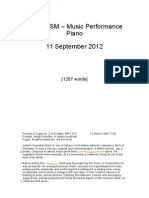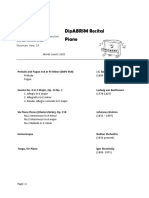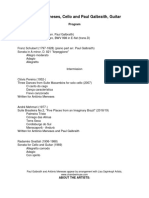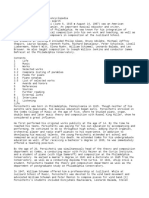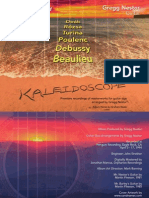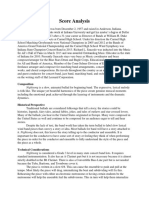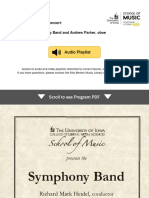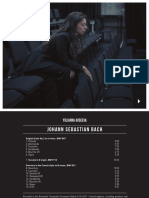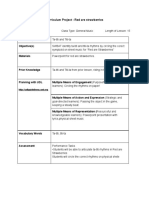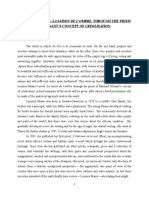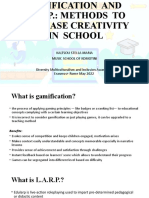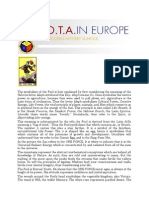Lauren Lupi
Bassoon Recital Program Notes Draft No. 1
Cello Suite No. 5, Prelude (c.a. 1720)
Johann Sebastian Bach
(1685-1750)
Originally written as technical exercises, the Bach Cello Suites were never
meant to be performance pieces. However, in the early 20th century, cellist
Pablo Casals came across the manuscripts and revived the music, uncovering
the mastery and beauty of each suite. The suites are now standard in the
cello repertoire.
Fifth of the Six Suites, this suite is set in the key of C minor. The prelude
begins in a French Overture style, with strong rhythmic emphasis on the
dotted eighth-sixteenth note pattern. The musical rhetoric and intervals used
throughout the prelude enhance the minor key. The prelude transitions to a
fugue section; the only fugue setting used in the set of suites. During this
section of the suite, Bach writes multiple voices within a single line, and the
listener is able to hear the complexity of the fugue. This fugue is more
lighthearted in character, and the movement ends on a C major chord.
German composer Johann Sebastian Bach was the technical and
countrapuntal master during the baroque period. He led a busy life as a
working composer throughout Europe, and also performed as an organist and
keyboardist. Some of his most recognized pieces include his B Minor Mass,
the Brandenburg Concertos, and of course, his six Cello Suites.
Mosaics: Trio for Flute, Bassoon, and Marimba
Eric Ewazen
I.
Barcarolle
b. 1954
II.
Fantasia and Fugue
III.
Pavane
IV.
Tarantella
(1993)
Eric Ewazen, an American composer, received his Bachelors of Music from
The Eastman School of Music, and holds both his Masters and Doctoral
Degrees from the Julliard School. He has a successful compositional career,
with multiple CD recordings of his music, commissions, and joint projects with
ensembles all over the country. His teachers include Milton Babbitt, Samuel
Adler, Warren Benson, and Gunther Schuller.
�Mosaics is a four-movement piece that displays both the lyrical and technical
capabilities of each of the wind instruments. The use of the five-octave
marimba links the two timbres and registers together of the flute and
bassoon. Ewazen puts great use to the extended ranges of the flute and
bassoon, and often the bassoon will be in its higher register, as a companion
to the flute; in contrast, the bassoon does play into its lower register, where it
meets the deeper end of the marimba. The use of the three instruments
provides a unique and beautiful color palate. The piece was written for flutist
Pat Zuber, percussionist Greg Zuber, and bassoonist Toni Lipton, all of the
Metropolitan Opera.
Saxophone Concerto in Eb Major (1934)
Alexander Glazunov
(1865-1936)
Trans.
Matthew Karr
b. 1956
Alexander Glazunov was a Russian composer during the late romantic period.
He was a child prodigy, and his compositional skills were recognized at an
extremely early age. He began his studies with Rimsky-Korsakov at the age
of 15. He himself became an educator, and held the position of Director at
the St. Petersburg Conservatory from 1905-1928. He embraced Western
Classical Romantic harmony, and wrote symphonies, ballets, and concertos
for various instruments.
His Saxophone Concerto is a single movement work, divided up by many
extreme tempo changes. The main theme travels through the sections,
varying not only in tempo, but also rhythmic and harmonic qualities.
Glazunov steered clear of the various compositional techniques of the
twentieth century during this time and utilized Western Classical Harmony,
using harmony and chromaticism to vary and ornament the music. The piece
was written for saxophonist Sigurd Rascher, and was Glazunovs last major
work before his passing.
Sonata for Clarinet and Bassoon (1922)
Francis Poulenc
I.
Allegro
(1899-1963)
II.
Romance
�III.
Final
Francis Poulenc, a French composer made a career in composition, as well as
an accomplished pianist. Poulenc was part of Les Six; a group of six French
composers who simply enjoyed each others company and frequently
programmed concerts together. His teachers include pianist Ricard Vines and
composer Erik Satie.
The Sonata for clarinet and bassoon is a whimsical piece for the two
woodwind instruments. The piece is a conversation between the two; melody
passes frequently from once voice to the other in solo passages, and often
meets back together in contrapuntal relationship and sometimes in unison.
Poulenc is very specific with his markings in not only dynamic and
articulation, but with written breaths and pauses within the music; creating
tension and suspense in the outer movements. In contrast, the middle
movement is one slow and continuous statement, in a reflective manner.
Get It! For Bassoon and Percussion (2011)
Gene Koshinski
b. 1980
Written for bassoonist David Campbell, Get It! for bassoon and percussion
offers the bassoonist an opportunity to unleash their inner rock star. The
piece is technical and flashy, as Campbell had asked for a piece written from
the popular music medium. Originally a solo work, the addition of the cajon
and high hat brings the piece to a whole other level of rock.
Gene Koshinski serves as Associate Professor of Percussion at the University
of Minnesota Duluth and is well known for his extraordinary versatility as a
solo, chamber, symphonic, jazz, pop, and world music artist. He has
performed in Argentina, Austria, Belgium, China, France, Germany, Japan,
Jordan, Slovenia, Canada, and throughout the United States. Most recently,
Koshinski was invited to perform at the 2014 International Patagonia
Percussion Festival in General Roca, Argentina. He holds his Bachelors of
Music Degree from Westchester University and a Masters from the Hartt
School of Music.
-Biography Information from Composers Webpage



